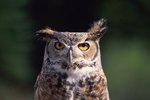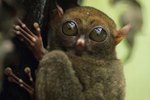
The eyes of nocturnal animals frequently serve as their most distinctive features, often bearing large, elliptical pupils that react quickly to changes in the light. These pupils, along with other physical adaptations, allow them to make the most out of whatever light is available and function in near darkness without difficulty.
Pupils
The pupil is a structure in the front of the eye that regulates how much light reaches the retina at the rear. In bright light, the pupil contracts, limiting the amount of light entering the eye to prevent dazzling and potential retinal damage. In the dark, the pupil relaxes, becoming larger to let in as much light as possible. Nocturnal animals generally have pupils that can open wider than those who thrive in the daylight hours.
Eye Size and Structure
In addition to large pupils, many nocturnal animals have extremely large eyes. This gives the pupil more room to expand, allowing it to become larger than some animals’ entire eyes when relaxed. Some nocturnal animals have eyes so large that they lack the musculature necessary to move in their sockets, keeping the eyes fused in a forward position. In the case of the tarsier and some species of owl, the animal compensates with an extremely flexible neck, allowing him to turn his head 180 degrees to collect as much visual information as possible from his surroundings.
Rods and Cones
The retina at the back of the eye contains two types of photoreceptors. Cones register detail and color, and work best in bright light. Rods detect movement, and function well in low-light situations. Nocturnal animals have more rods than cones to utilize what light flows in through their dilated pupils. Some nocturnal animals lack cones entirely, making them adept at detecting movement but poor at recognizing fine details. Camouflage works well against predators with this kind of adaptation, and prey that stands still might prove invisible to these hunters.
Tapetum
While the extremely large pupil of a nocturnal animal lets in all the light it can, it may not be enough to provide a good picture of the surrounding area. Many nocturnal creatures have an additional layer of eye cells called the tapetum, which sports a shiny, reflective surface. This reflects any light that passes through the retina back through the detector cells, allowing the animal’s nervous system another chance to detect images. You can witness a demonstration of this effect by shining a penlight at a cat in a dark room. When the angle of the light strikes the cat’s eyes just right, they will seem to glow unnaturally as the tapetum reflects the beam back at you.
References
Photo Credits
-
Stockbyte/Stockbyte/Getty Images
Writer Bio
Milton Kazmeyer has worked in the insurance, financial and manufacturing fields and also served as a federal contractor. He began his writing career in 2007 and now works full-time as a writer and transcriptionist. His primary fields of expertise include computers, astronomy, alternative energy sources and the environment.



